How Ocean Freight Logistics Works in 2025
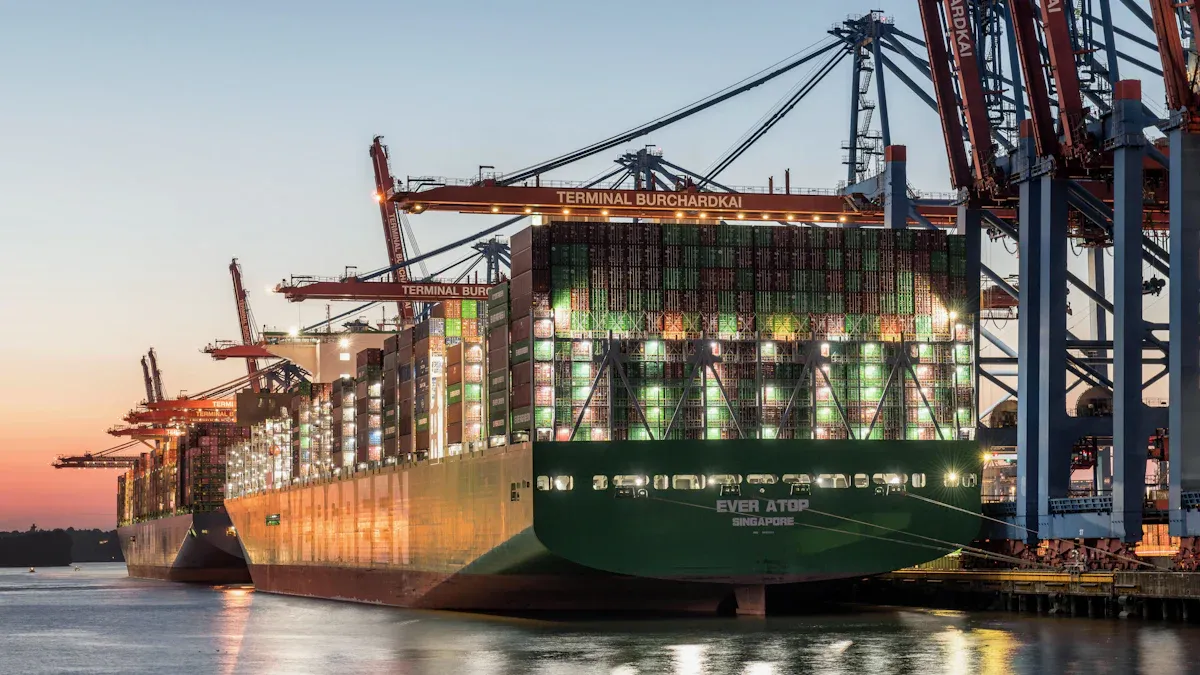
You see ocean freight logistics in 2025 as quick and connected. Real-time tracking, IoT, and AI let you watch shipments at every step. Integrated platforms give you full control and help stop delays. JUSDA leads this change by using smart digital tools to make shipping better.
Key Takeaways
Technology like AI, IoT, and digital platforms help ocean freight move faster. They make things clearer and easier to handle in 2025.
JUSDA’s smart tools let you see where shipments are right now. They help you stop delays and keep costs low.
Pick ocean freight for big shipments that are not urgent to save money. Use digital tools to plan and watch every step.
Process Overview
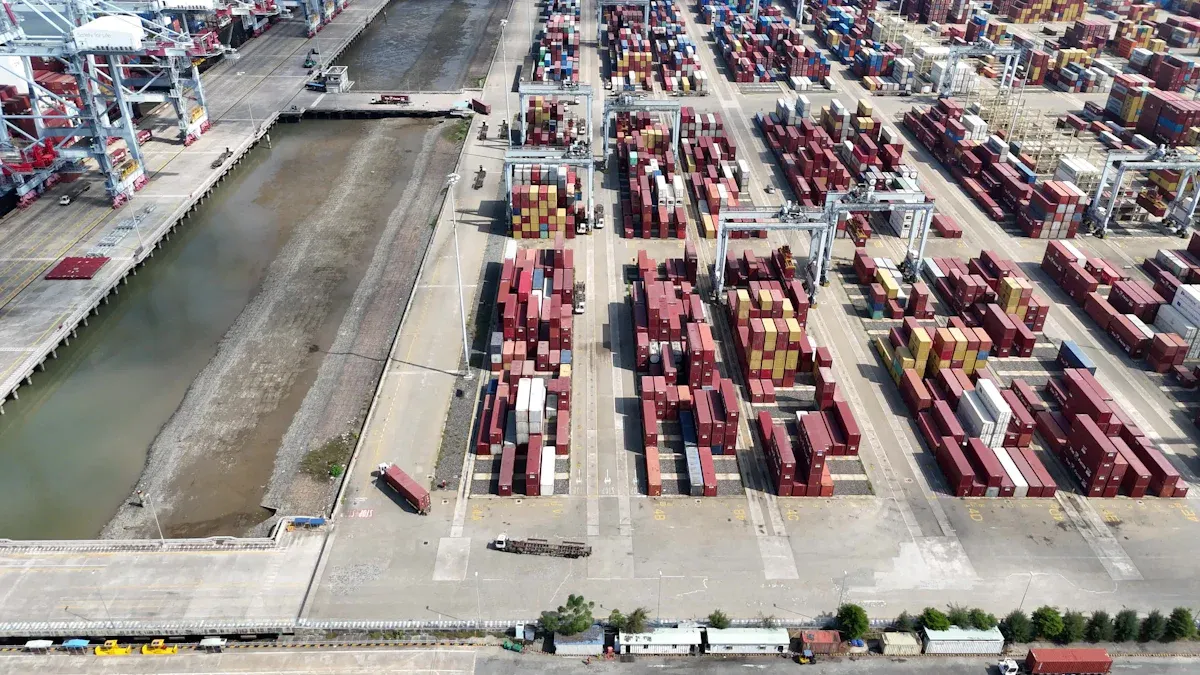
In 2025, ocean freight logistics uses smart technology and platforms. These tools make shipping easy and dependable. You can see each step, from booking to delivery. Real-time tracking and digital tools help you follow your shipment. JUSDA’s JusLink platform and AI-driven solutions let you manage every stage quickly and accurately.
Booking & Documentation
You begin by booking your shipment and getting documents ready. In 2025, you do not fill out lots of forms by hand. JUSDA’s supply chain platform uses AI to pull data from bills of lading, booking confirmations, and invoices. This makes it easy to create and update shipments right away. You save time and make fewer mistakes. The JusLink Digital System links your information to JUSDA’s network. You always have the newest details.
Tip: Automated booking and documentation save time and cut down on manual work.
Cargo Handling
After booking, your cargo is handled and prepared. IoT sensors track containers and check equipment health. AI and machine learning predict when machines need fixing and send help where needed. Autonomous vehicles and drones move goods, count inventory, and check containers. Blockchain records every step, making transactions safe and easy to follow.
You see fewer mistakes and faster loading.
Digital twins show a virtual port, so you can watch and improve cargo flow.
Green technology, like electric cranes, helps the environment.
Port & Customs
At the port, your cargo goes through customs and may face delays. Problems can be wrong paperwork, unclear codes, or busy ports. JUSDA’s experts and digital tools help you avoid these problems.
You work with skilled customs brokers who know the rules.
The platform checks your documents for accuracy and compliance.
Real-time updates show where your cargo is in customs.
You can plan ahead to avoid busy times and save money.
Note: Correct documents and expert help let you clear customs faster and avoid extra fees.
Ocean Transit
Your cargo crosses the ocean with full visibility. AI-powered solutions and IoT sensors give you updates every minute. You can see your shipment’s location, route, and condition anytime. If there is a storm or port congestion, the system suggests new routes.
You get alerts about possible delays.
The platform helps you make fast choices to keep cargo moving.
All partners see the same data, so everyone knows what is happening.
Delivery & Tracking
When your cargo arrives, real-time tracking keeps going until delivery. You can follow your shipment from the port to your door using apps, GPS, and RFID tags. The system records every step, including who handled your cargo and when.
You get instant notifications about delivery status.
Barcode scanning at each point keeps your information current.
Electronic proof of delivery and customer feedback help make service better.
Real-time tracking gives you peace of mind and helps you fix problems early.
Step-by-Step Summary Table
Stage | What You Do | How JUSDA Helps You |
|---|---|---|
Booking & Docs | Book shipment, prepare documents | AI automation, JusLink integration |
Cargo Handling | Load and secure cargo | IoT, AI, drones, blockchain, green tech |
Port & Customs | Clear customs, handle inspections | Expert brokers, digital compliance checks |
Ocean Transit | Ship across the ocean | Real-time tracking, predictive analytics |
Delivery & Tracking | Receive and confirm delivery | GPS, RFID, instant updates, e-proof |
Ocean freight logistics in 2025 gives you more control, speed, and transparency at every step. JUSDA’s smart solutions make global shipping easier than ever.
Ocean Freight Logistics Services
FCL & LCL Options
You can pick FCL or LCL for sea shipping. FCL means you get the whole container for your goods. This is best if you have a lot to ship. It is faster and safer. There is less handling of your cargo. LCL lets you share a container with others. You only pay for the space you use. This is good for smaller shipments. LCL can take longer because there are more stops. Your cargo is handled more often.
Factor | LCL (Less-than-Container Load) | FCL (Full-Container Load) |
|---|---|---|
Shared with others | Exclusive use | |
Cost model | Pay by volume | Fixed rate per container |
Transit speed | Slower, more stops | Faster, direct |
Security | More handling, higher risk | Sealed, lower risk |
Flexibility | High, good for many destinations | Best for one destination |
Ideal shipment size | Small to mid-sized | Large, high-volume |
Tip: FCL is great for big and regular shipments. LCL is better for small or rare loads.
Specialized Solutions
Some goods need special care when shipped. JUSDA has solutions for electronics, car parts, FMCG, and medical equipment. You get help with inventory and cross-border shipping. Real-time tracking lets you see your shipment at all times. JUSDA helps with customs and following the rules. Your cargo will be safe and on time, even across borders.
Full service with customs and rule support
Track every shipment in real time
JUSDA Industry Services
JUSDA makes ocean freight work for your business. You get cloud storage, centers for combining goods, and delivery hubs. The JusLink platform shows you where your goods are and helps automate tasks. JUSDA helps you keep track of stock and cut down wait times. You can follow local rules and grow your business.
Service Type | Description | Industries Served |
|---|---|---|
Vendor Managed Inventory | Keeps stock ready and avoids delays | Electronics, Automotive |
Warehousing & Distribution | Flexible storage and delivery | Medical, FMCG |
Customs Clearance & Compliance | Easy customs process in all markets | All sectors |
Sustainability Initiatives | Helps lower carbon footprint | All sectors |
Note: JUSDA’s extra services help you ship better and grow your business.
Cost Factors
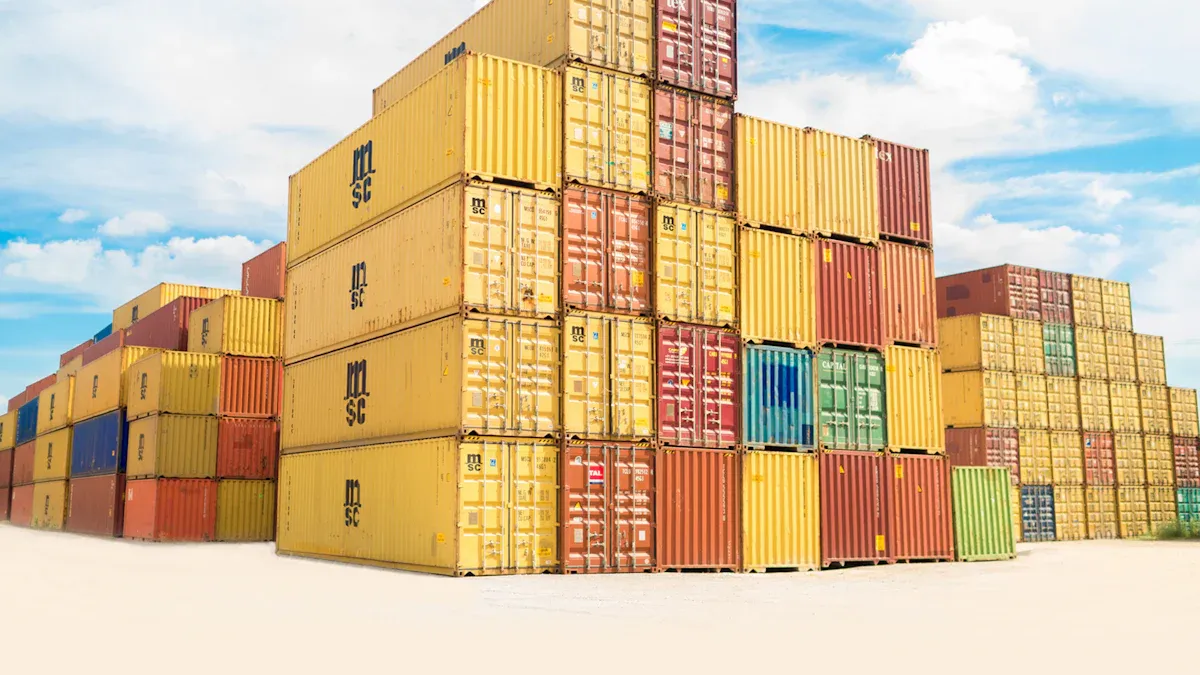
Rate Calculation
You want to know what makes up the cost of shipping by sea in 2025. Many things affect the price you pay for ocean freight logistics. Here are the main factors:
Geopolitical events can change shipping routes and add costs. For example, trouble in the Suez Canal or new trade rules can raise prices.
Economic trends like inflation or changes in where goods are made can shift demand and rates.
Fuel costs matter a lot. When fuel prices go up, so do shipping costs. Greener fuels like LNG or biofuels can also add to the price.
Environmental rules now require cleaner ships. These rules can mean extra fees or taxes.
Supply and demand change prices. If many people need containers or ports get crowded, rates rise.
Labor strikes or problems at ports can slow things down and make shipping more expensive.
Route selection also plays a big part. Shorter routes use less fuel and cost less. Some ports charge higher fees. Fast routes may cost more but save you time.
Digital platforms like JUSDA’s JusLink help you save money. You get instant quotes, compare rates, and see all fees up front. The system uses data to find the best routes and times to ship. You avoid hidden costs and make better choices.
Tip: Using a digital platform helps you control costs and see every charge before you ship.
Example Costs
You can see how much it costs to ship a standard container on major routes in 2025:
Route | Freight Cost (USD per FEU) |
|---|---|
Asia to US West Coast | |
Asia to US East Coast | $3,467 |
Asia to Northern Europe | $2,340 |
Asia to Mediterranean | $2,935 |
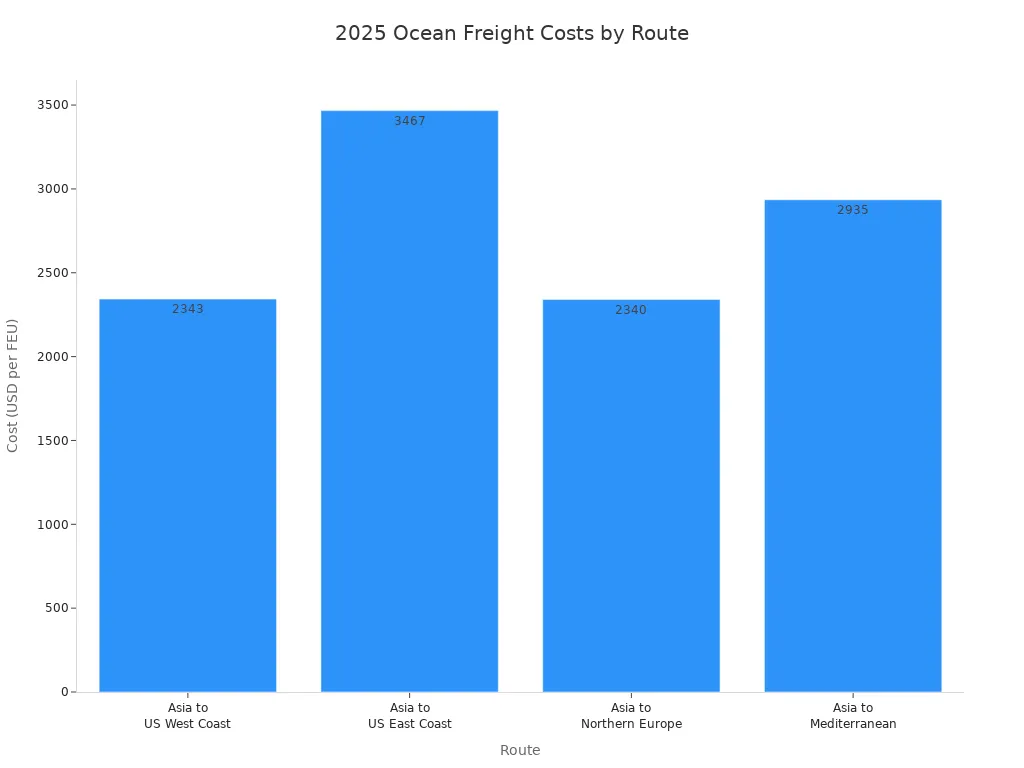
Container prices also change by size and condition. For example, a used 20ft container in the US can cost $1,600 to $2,500. Delivery to your door adds $300 to $1,200 more.
Ocean freight logistics in 2025 gives you more tools to manage costs and plan your shipments with confidence.
Transit Times
Average Durations
You might wonder how long ocean shipping takes. The time depends on the route and other things. Here is a table with usual times for big shipping routes in 2025:
Route | Average Transit Time (days) | Notes on Variability and Factors Affecting Transit Time |
|---|---|---|
China to Australia | 25 - 35 | Seasonal changes, holidays like Chinese New Year |
USA to Singapore | 15 - 25 | Can range up to 46 days with container shipping |
China to Europe | 30 - 45 | Long route, Suez Canal, possible diversions |
China to the UK | 35 - 45 | Varies by port, door-to-door takes longer |
UK to Australia | 30 - 40 | Arrival port in Australia changes timing |
These times can change if there is bad weather or busy ports. Special events can also make trips take longer. The Portcast Transit Time Trends Report says port congestion and new shipping routes have made some trips slower, especially from Asia.
Influencing Factors
Many things can slow down your shipment. Port congestion is a main cause of delays. When ports are crowded, ships must wait to dock and unload. This happens more during busy times or at ports with old machines. You can skip some delays by picking ports with new equipment and less traffic.
Tip: Ship during less busy times and use ports with good equipment to help your delivery stay on time.
Technology now helps stop many delays. Here are some ways new tools make ocean shipping faster and more dependable:
Digital systems do tracking and paperwork, so you make fewer mistakes.
IoT devices on containers let you see your cargo at all times.
AI finds problems early and helps you choose the best route.
Blockchain keeps your documents safe and easy to check.
Digital freight platforms link you with more carriers and partners.
JUSDA uses these tools to give you updates and smart route choices. You can see where your shipment is at every step. If something goes wrong, you get alerts and answers fast. This helps you trust your delivery will be on time, even if things change.
Pros & Cons
Advantages
There are many good things about ocean freight logistics in 2025.
You spend less money when you ship big loads. Ocean freight is best for moving lots of goods and helps you save money.
You can plan your shipments early to avoid sudden price increases.
Trans-shipment hubs let you change your cargo’s path if there are problems, like blocked routes or unrest.
There are more carriers to pick from, so you can get better prices and flexible times.
Digital tools let you check prices and watch your shipment live.
Ocean freight has lots of room for goods, so it works well for things that do not need to arrive fast.
JUSDA’s JusLink platform shows you each step, helps you manage stock, and gives quick updates.
JUSDA’s team helps with customs, storage, and delivery, making shipping easy and safe.
Note: JUSDA’s strong network and smart tech help you skip common shipping problems and keep your supply chain working well.
Limitations
There are also some things that make ocean freight logistics harder.
Shipments take more time because ships are slow and stop at many ports. This makes ocean freight not the best for things that spoil or need to arrive fast.
If you ship to places far from the sea, you need extra transport, which costs more and makes things harder.
Bad weather, pirates, or unrest can slow down your cargo or put it in danger.
Ports that are old or crowded can make your shipment slow and cost more.
Ocean freight is not as flexible as air or land shipping for things that must arrive quickly.
JUSDA helps you with these problems by using local storage, live tracking, and skilled teams to fix issues fast.
When to Choose Ocean Freight
Best Scenarios
You should choose ocean freight when you need to move large or heavy shipments. This method works best for bulk goods, seasonal products, or when you want to save money on shipping. Many companies use ocean freight for big orders because the cost per kilogram is much lower than air shipping. If you can plan ahead and do not need fast delivery, ocean freight gives you the best value.
Ports with modern equipment and automation help your cargo move quickly and safely.
Advanced container handling and route planning reduce delays and lower costs.
Shipping during off-peak times or avoiding major holidays, like Chinese New Year, helps you skip extra fees and long waits.
Combining goods with others in one container (consolidation) saves even more money.
JUSDA helped Sharp, a global electronics brand, cut logistics costs by 20% and speed up deliveries by 30%. Sharp used JUSDA’s smart platform to manage inventory, plan shipments, and track cargo in real time. This made their supply chain more efficient and reliable.
Tip: Ocean freight is your best choice for high-volume, non-urgent shipments, especially when you want to keep costs low.
Alternatives
Sometimes, you need to look at other shipping options. Air freight works well for urgent, high-value, or perishable goods. Rail and land transport fit regional or shorter trips, giving you flexibility and moderate costs. If ports are crowded or you face delays, switching to another mode can keep your supply chain moving.
Use air freight for fast delivery of small or valuable items.
Pick rail or truck for regional shipments or when you need a flexible schedule.
Combine sea, air, and land transport to balance speed, cost, and reliability.
JUSDA supports you with a smart transportation management platform. You get real-time updates, flexible routes, and help with customs. JUSDA’s team connects rail, road, and sea to give you the best path for your cargo. You can adapt quickly if trade routes change or new rules appear.
Note: Choosing the right mode depends on your shipment’s size, urgency, and budget. JUSDA helps you find the best solution for every need.
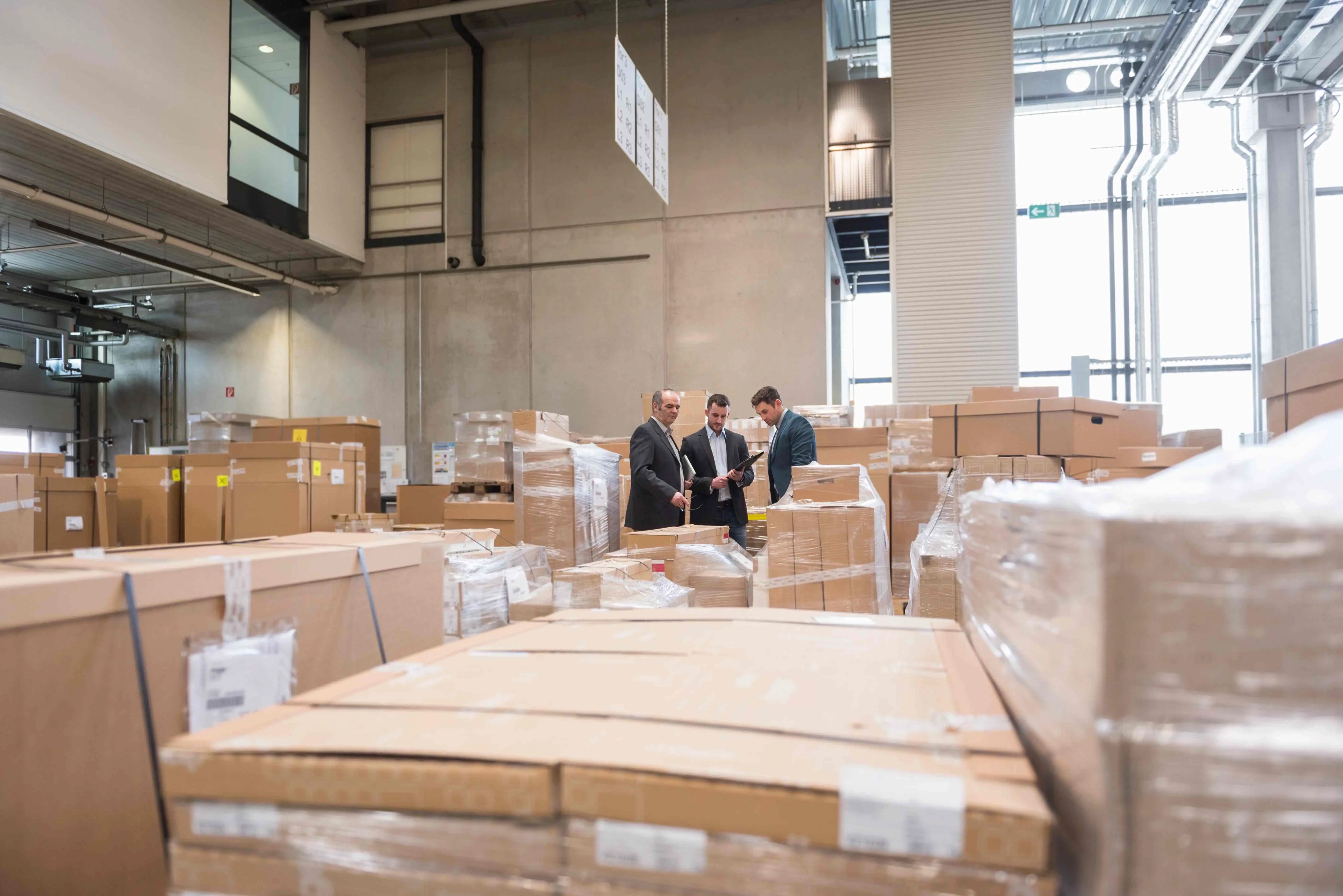
JUSDA Solutions
To provide you with professional solutions and quotations.
You notice that technology is making shipping different in 2025.
AI and IoT let you watch your shipments and plan easier.
JUSDA’s JusLink platform shows you live updates and helps you make smart choices.
You can make your supply chain better by doing these things:
Think about what you need to ship and how much you can spend.
Use digital tools to track your shipments and plan your moves.
Pick trusted partners like JUSDA so your shipping is safe and on time.
For more ideas, check out guides about supply chain management and digital logistics.
See Also
Discover The Latest Trends In Sea Freight Logistics 2024
In-Depth Look At The Future Of LTL Freight Shipping
How Artificial Intelligence Is Transforming Supply Chain Logistics
Digital Innovations Shaping The Future Of Logistics Industry
Preparing For The Newest Transport Technologies In Supply Chains
